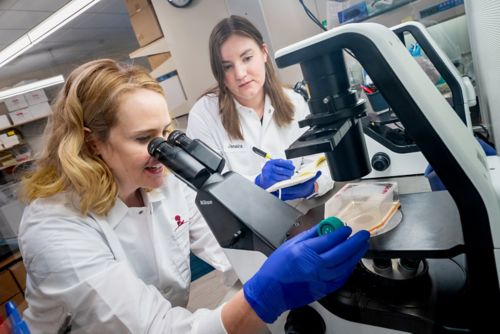St. Jude Family of Websites
Explore our cutting edge research, world-class patient care, career opportunities and more.
St. Jude Children's Research Hospital Home

- Fundraising
St. Jude Family of Websites
Explore our cutting edge research, world-class patient care, career opportunities and more.
St. Jude Children's Research Hospital Home

- Fundraising
Shondra Pruett-Miller Lab
Developing and optimizing genome-editing methodologies to advance basic research and support clinical therapies.
About the Pruett-Miller Lab
In the Pruett-Miller laboratory, we are interested in all things related to genome-editing. We aim to optimize current genome-editing strategies as well as develop novel techniques that can be used to further our understanding of disease. Our work will provide the scientific community with reliable methodologies that can be applied to a variety of research questions.
Our research summary
Genome-editing has been the subject of scientific inquiry for decades. Since its initial development, genome-editing technologies are constantly created and evolving to overcome experimental limitations and technical barriers.
Our lab strives to improve the process of genome-editing. We aim to make these methodologies more robust and more reliable so they can be used as a platform for basic and translational research.
Increasing homology-directed repair events
Eukaryotic cells repair double-stranded breaks through either non-homologous end-joining repair or homology-directed repair (HDR). HDR is a more accurate and definable way to repair a double-stranded break and, thus, a more precise way to edit the genome. We are interested and developing strategies to increase the number of HDR repair events.

Optimizing targeted deletions
Diseases are often characterized by a particular deletion or translocation event. To create useful model systems to study these diseases, we must be able to edit the genome of our model organism to genetically match that of the disease state. Reliable targeted deletion strategies will allow us to precisely replicate disease genetics in the laboratory and, therefore, allows for the creation of a myriad of model systems.

1.a. Digital image of artificial intelligence human brain.
Translational applications
Our group is highly collaborative which has allowed the methodologies we develop and optimize to be utilized in a translational capacity.
Acute lymphoblastic leukemia
Oncogenic fusions are a major driver of cancer in both adults and children, making these cancer-specific hybridized genes attractive targets for therapeutic interventions. In collaboration with the Department of Computational Biology, we used in vitro CRISPR-Cas9 editing in acute lymphoblastic leukemia cell lines to validate oncogenic fusions regulated by alternative splicing. Our contribution has helped narrow the list of the genetic fusions that should be considered for therapeutic targeting.
Hemoglobinopathies
Hemaglobinopathies are genetically characterized by mutations that change the structure or production of hemoglobin. These mutations provide an attractive target for correcting the pathophysiology of the disease at the level of the gene.
We are modeling hypotheses, developing disease models and collaborating with the Department of Hematology to develop novel therapeutics for hemoglobinopathies such as Hb SC — a form of sickle cell disease characterized by a Glu-to-Lys modification — and hemoglobin E β-thalassemia — characterized by a single nucleotide substitution in the HBB gene that can cause severe hemolytic anemia when co-inherited with other genetic anomalies. Our work has been instrumental in bringing genome editing to the clinic.
Learn more
Publications
Contact us
Shondra Pruett-Miller, PhD
Associate Member, St. Jude Faculty
Vice President, Cancer Center Shared Resources
Department of Cell & Molecular Biology
MS 340, Room D5048E
St. Jude Children's Research Hospital

Memphis, TN, 38105-3678 USA GET DIRECTIONS


